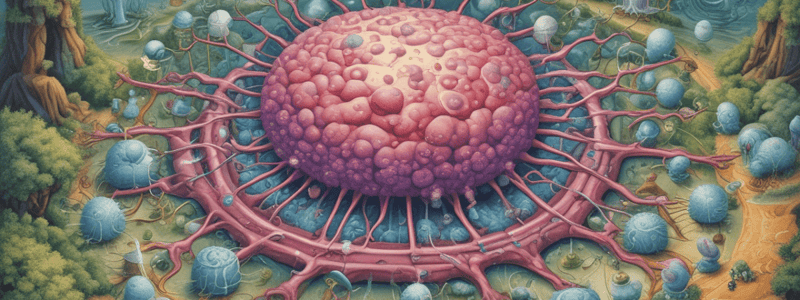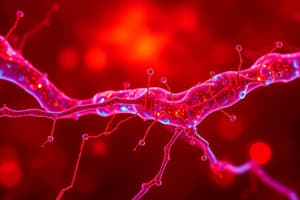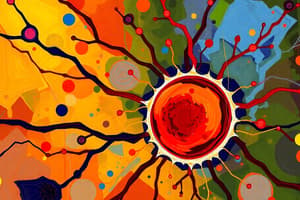Podcast
Questions and Answers
Passive transport requires energy input.
Passive transport requires energy input.
False (B)
Mitosis results in four genetically unique daughter cells.
Mitosis results in four genetically unique daughter cells.
False (B)
Cell signaling involves the transportation of molecules into and out of cells.
Cell signaling involves the transportation of molecules into and out of cells.
False (B)
Photosynthesis occurs in the mitochondria of plant cells.
Photosynthesis occurs in the mitochondria of plant cells.
Transcription is the process of RNA translating to protein.
Transcription is the process of RNA translating to protein.
Autocrine signaling affects distant cells.
Autocrine signaling affects distant cells.
Cellular respiration occurs in chloroplasts.
Cellular respiration occurs in chloroplasts.
Osmosis is the movement of molecules from low to high concentration.
Osmosis is the movement of molecules from low to high concentration.
Flashcards are hidden until you start studying
Study Notes
Cellular Processes
Cell Signaling
- The process by which cells communicate with each other and respond to their environment
- Involves signal transduction pathways, which allow cells to respond to stimuli
- Types of cell signaling:
- Autocrine signaling: signals that affect the same cell that produced them
- Paracrine signaling: signals that affect nearby cells
- Endocrine signaling: signals that affect cells distant from the signaling cell
- Direct signaling: signals that directly affect adjacent cells
Cellular Transport
- The movement of molecules into, out of, and within cells
- Types of cellular transport:
- Passive transport: movement of molecules down their concentration gradient
- Diffusion: random movement of molecules from high to low concentration
- Osmosis: movement of water molecules from high to low concentration
- Active transport: movement of molecules against their concentration gradient
- Requires energy input
- Examples: pumps, carriers, and vesicle transport
- Passive transport: movement of molecules down their concentration gradient
Cell Division
- The process by which a cell divides into two daughter cells
- Types of cell division:
- Mitosis: division of somatic cells, resulting in two genetically identical daughter cells
- Meiosis: division of gametes (sperm or egg cells), resulting in four genetically unique daughter cells
Photosynthesis
- The process by which cells convert light energy into chemical energy
- Occurs in chloroplasts of plant cells and some algae
- Equation: 6 CO2 + 6 H2O + light energy → C6H12O6 (glucose) + 6 O2
Cellular Respiration
- The process by which cells convert glucose into energy (ATP)
- Occurs in mitochondria of cells
- Equation: C6H12O6 (glucose) + 6 O2 → 6 CO2 + 6 H2O + ATP (energy)
Protein Synthesis
- The process by which cells create proteins
- Involves transcription of DNA to RNA, and translation of RNA to protein
- Steps:
- Transcription: DNA → RNA
- Translation: RNA → protein
- Post-translational modification: protein folding and modification
Cellular Processes
Cell Signaling
- Cell signaling involves signal transduction pathways, allowing cells to respond to stimuli
- Types of cell signaling:
- Autocrine signaling: signals that affect the same cell that produced them
- Paracrine signaling: signals that affect nearby cells
- Endocrine signaling: signals that affect cells distant from the signaling cell
- Direct signaling: signals that directly affect adjacent cells
Cellular Transport
- Cellular transport is the movement of molecules into, out of, and within cells
- Passive transport: movement of molecules down their concentration gradient
- Diffusion: random movement of molecules from high to low concentration
- Osmosis: movement of water molecules from high to low concentration
- Active transport: movement of molecules against their concentration gradient, requiring energy input
- Examples: pumps, carriers, and vesicle transport
Cell Division
- Cell division is the process by which a cell divides into two daughter cells
- Types of cell division:
- Mitosis: division of somatic cells, resulting in two genetically identical daughter cells
- Meiosis: division of gametes (sperm or egg cells), resulting in four genetically unique daughter cells
Photosynthesis
- Photosynthesis converts light energy into chemical energy
- Occurs in chloroplasts of plant cells and some algae
- Equation: 6 CO2 + 6 H2O + light energy → C6H12O6 (glucose) + 6 O2
Cellular Respiration
- Cellular respiration converts glucose into energy (ATP)
- Occurs in mitochondria of cells
- Equation: C6H12O6 (glucose) + 6 O2 → 6 CO2 + 6 H2O + ATP (energy)
Protein Synthesis
- Protein synthesis involves transcription of DNA to RNA, and translation of RNA to protein
- Steps:
- Transcription: DNA → RNA
- Translation: RNA → protein
- Post-translational modification: protein folding and modification
Studying That Suits You
Use AI to generate personalized quizzes and flashcards to suit your learning preferences.




